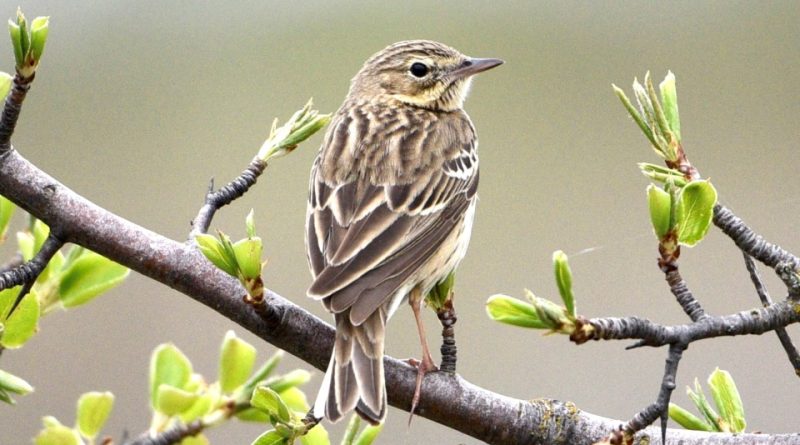Anthus trivialis
Anthus trivialis
The tree pipit (Anthus trivialis Linnaeus, 1758) is a bird belonging to the Motacillidae family.
Systematic –
From a systematic point of view it belongs to:
Eukaryota domain,
Kingdom Animalia,
Phylum Chordata,
Subphylum Vertebrata,
Aves class,
Subclass Neornithes,
Superorder Neognathae,
Order Passeriformes,
Suborder Oscines,
Passerida infraorder,
Superfamily Passeroidea,
Family Motacillidae,
Genus Anthus,
Species A. trivialis.
The term is basionym:
– Alauda trivialis Linnaeus, 1758.
The term is synonymous:
– Anthus arboreus Bechstein.
The following subspecies are recognized within this species:
– Anthus trivialis subsp. haringtoni Witherby, 1917;
– Anthus trivialis subsp. trivialis.
Geographic Distribution and Habitat –
The Anthus trivialis is a bird present in Europe, Asia and Africa.
It is very widespread on the European continent, with a very vast area of presence: from Northern Europe to Asia, up to India.
Its preferential habitat is that of both lowland and mountain woods where it resists even harsh climates and nests in medium and medium-high latitudes, up to the border with the Arctic regions. In the winter months, however, it migrates south of the Sahara, seeking, where possible, environments relatively similar to those favored during the summer season in the north, namely: trees that are sufficiently large but well spaced from each other and hospitable soils in which to build the nest.
In Italy it is a species of passage and nests in the Apennine areas and in the pre-Alps.
Description –
The Anthus trivialis is a bird with a length of about 16 cm, with a wingspan of 25-30 cm, weighing about 24 g.
Both sexes have a brown color on the upper parts with marked cream and very dark brown streaks. Even young people are very similar.
The beak is quite tapered and is pink in color with blackish shades and the legs are pink in color.
The lower parts are variable in color between dirty white and beige, they are very streaked with brown, especially on the throat and upper part of the chest, and then fade towards the abdomen and sides.
It can be distinguished from Anthus pratensis which is slightly smaller, due to the heavier bill and the greater contrast between the buff colored chest and the white belly.
The call is strong, unlike the weak call of its congener, and the song becomes more prolonged towards the end.
The bird rises a short distance from a tree, and then swoops down with stiff wings.
Biology –
The Anthus trivialis is a bird that reproduces in habitats with a woodland component, including lowland moorland and coppiced woods. It is found mainly in open woodland bordering moorland or in open structured oak woodland.
It prefers medium-sized trees with low canopy, where there are low bushes and brambles less than 2 meters high, so horizontal visibility is relatively high. It also prefers areas with a mosaic of grass and ferns, with short turf that is not heavily grazed, so light to moderate grazing is preferred.
The nest is built by the female. The clutch consists of 4 to 6 eggs and is incubated by the female. The eggs hatch after 12-14 days. The young are fed by both parents and leave the nest after 12-14 days. The nests are sometimes parasitized by the Cuculus canorus.
The life cycle runs from mid-September to mid-April in sub-Saharan Africa; from mid-April to early May it migrates to northern countries, from early May to August there is the reproductive season, with two broods, and from August to mid-September it returns to Saharan Africa.
During the brooding period the male lingers in the immediate vicinity of the nest, normally perches on a post or on wires and sings continuously.
Ecological Role –
The Anthus trivialis is a migratory bird that feeds mainly on invertebrates, typically insects, but also eats plant material. Nutrition occurs mainly on the ground, in areas with the presence of trees where there are low bushes and short brambles and with the presence of grass and ferns.
The population of this bird, like many species, is globally in decline although it is currently classified according to the IUCN as least concern.
Guido Bissanti
Sources
– Wikipedia, the free encyclopedia.
– GBIF, the Global Biodiversity Information Facility.
– C.Battisti, D. Taffon, F. Giucca, 2008. Atlas of nesting birds, Gangemi Editore, Rome.
– L. Svensson, K.Mullarney, D. Zetterstrom, 1999. Guide to the Birds of Europe, North Africa and the Near East, Harper Collins Publisher, United Kingdom.
Photo source:
– https://inaturalist-open-data.s3.amazonaws.com/photos/269468657/original.jpg
– https://en.wikipedia.org/wiki/Tree_pipit#/media/File:Tree_Pipit_Gr%C3%B6nvold.jpg


